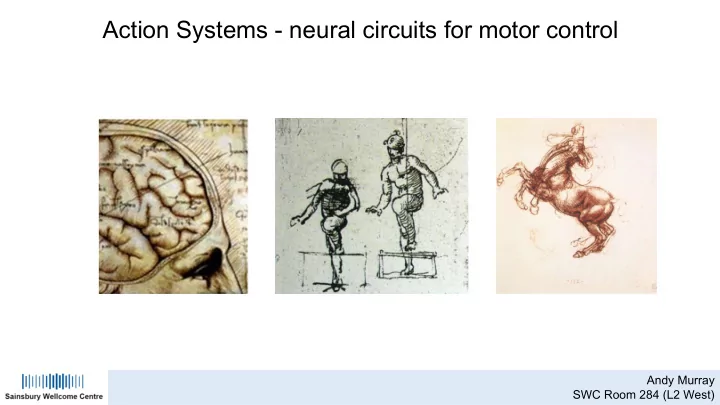

Action Systems - neural circuits for motor control Andy Murray SWC Room 284 (L2 West)
Lecture overview Mon 12 th Motor systems overview Andy Murray Tues 13 th Pattern generation Peter Latham Fri 16 th Computational control Maneesh Sahani Mon 9 th Cerebellum Tom Otis Tues 20 th Basal Ganglia Marcus Stephenson-Jones Fri Nov 23 rd Neocortex/Discussion Andy Murray/Maneesh Sahani
Practical overview Week 1 - Build a fiber photometry rig (lecture/tutorial this afternoon) - Surgery – virus injection and fiber optic implant tutorial (tomorrow) Week 2 - Design experiments to test motor control in mice - Use you photometry rig to record from the mice injected in week 1
Motor control is our only means to interact with the environment
We are surprisingly bad at recreating natural movement
Which parts of the nervous system are involved in motor control? Reading: Connecting neuronal circuits for movement Arber & Costa, Science 2018 Vol. 360, Issue 6396, pp. 1403-1404
Muscles and motor neurons
Muscles and motor neurons
Spinal circuitry – organisation of motor neurons
Spinal circuitry – organisation of limb motor neurons Motor unit Motor columels Motor columns Motor pool agonist antagonist
Simple motor control is based on rhythmic movements Hindlimb EMG Extensor Flexor
The locomotor step cycle
The spinal cord can generate rhythmic locomotion Intact Spinalised (T13; 38 days) Rossignol and Bouyer, 2004
Build a rhythmic spinal circuit….. Extensor Flexor
Pacemaker neurons Crustacean stomatogastric ganglion Respiratory centres
Sensory pathways could drive rhythmic firing in the spinal cord Extensor Flexor
The spinal cord can generate rhythmic firing of motor neurons (in the absence of sensory feedback) Machado et al., 2015
Locomotion is based on rhythmic movements generated in the spinal cord T. Graham Brown Brown, 1914
Reciprocal inhibition
The unit burst generator as an alternative to the half-centre model
The unit burst generator as an alternative to the half-centre model Grillner
The unit burst generator as an alternative to the half-centre model
The diversity of spinal interneurons Reading: Goulding, 2009. Nat. Rev. Neurosci. Circuits controlling vertebrate locomotion: moving in a new direction.
Why do we need a brain? 1. To start/stop locomotion 2. To adjust ongoing motor commands 3. When we want conscious control over our movements
Starting locomotion – the MLR
Locomotor transitions and choosing a gait
Activation of spinal CPGs – the mesencephalic locomotor region
The MLR is conserved across species Sirota et al., 2000
Tomorrow’s practical – stimulating and recording from the MLR in mice
Adapting the spinal rhythm via descending brainstem pathways
Descending pathways modify and modulate spinal circuits a snapshot of 27 descending tracts…. Reading: Ferreira-Pinto et al., 2018. Neuron. Connecting circuits for supraspinal control of locomotion.
Reticulospinal pathways excite both extensors and flexor motor neurons Wilson and Yoshida, 1969
Reticulospinal pathways – the command neurons for movement (?)
Individual descending axons can influence multiple spinal circuits Reticulospinal Vestibulospinal
The nervous system (probably) doesn’t care about individual muscles Markin et al., 2012; Ting and McKay, 2007
Adaptable movement
Movement must be flexible Da Vinci, ~1500 Borelli, 1681 Marey, 1873
Postural control is an active process that requires descending commands
Postural control is an active process that requires descending commands Macpherson and Fung, 1999
Postural control is an active process that requires descending commands
Postural control and balance – you only notice when it’s not there Courtesy of Prof. Fay Horak, OHSU
Postural pathways Deliagina et al., 2014
Vestibulospinal tracts Maintain balance and posture using rotation and acceleration of the head cervical lumbar
The lateral vestibular nucleus projects to all spinal levels Fluorogold (lumbar SC) Nissl cervical lumbar
Vestibulospinal pathways are required for reflexive balance control
Vestibulospinal pathways generate a contextually appropriate motor program to maintain balance With lateral vestibulospinal pathway Extensors Flexors Without lateral vestibulospinal pathway
Vestibulospinal neurons are not required for treadmill locomotion Ablation Control
Motor systems overview Mon 12 th Tues 13 th Pattern generation Fri 16 th Computational control Mon 9 th Cerebellum Tues 20 th Basal Ganglia Fri Nov 23 rd Neocortex/Discussion
Muscles and motor neurons
Reticulospinal pathways have diffuse projections into the spinal cord Liang et al., 2015
Recommend
More recommend